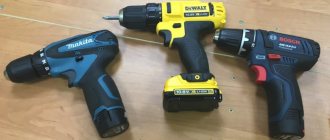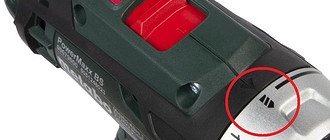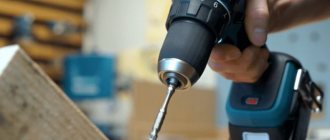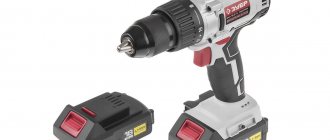Attachments for drills, screwdrivers and grinders for polishing cars - types and their choice
All car owners value their vehicle. Some even associate a car with their second home. All car enthusiasts are especially sensitive to the appearance and condition of the car. Even minor scratches and damage can ruin the mood of the car owner.
Why do you need to polish a car body?
But how can you make your car look more attractive and presentable? One way to maintain a presentable form of transport is by polishing. Polishing removes scratches, small chips and other subtle defects. The basic concept of polishing is that car mechanics remove a thin layer of paintwork. This allows you to get rid of scratches and chips, as well as return the car to a fresh, presentable look without damaging the paintwork.
Each type of work has its own disk
It is important to use your own disk for each type of work. Cutting wheels cannot be used for stripping and vice versa. Based on this, it is possible to divide the types of disks by type of work.
- If it is necessary to cut or saw, then use cutting discs.
- If you have to cut wood products, use saw blades.
- If you need to peel off old layers of paint and varnish materials and primer or make the surface smooth, you need a roughing or grinding disc.
- You can process metal, wood, and plastic products with a flap disc.
- For final polishing of surfaces, a polishing disc is best.
Types of polishing work
Restorative polishing is divided into soft and deep. They differ only in the degree of varnish removal. Soft polishing removes a relatively small layer of paintwork. This is enough to hide the “spider web” effect or save the car from minor scratches. For deeper defects, it is better to use deep polishing, which will cope with scratches, small chips, etc.
Processing technology
Before polishing, the workpiece must be washed and cleaned of all kinds of contaminants. If grinding is necessary, put on an abrasive wheel and start grinding. Do not forget to wet the surface to be treated to avoid additional scratches. After sanding, wipe the surface. Apply the polish to the polishing wheel, rub it over the part and begin polishing it. To avoid overheating the surface, do not press hard on the tool and polish one area for a long time. When finished, use a soft, lint-free cloth to remove any remaining polish.
To attach polishing wheels to a hand-held electric drill, you will need an adapter and so-called “Velcro” (a backing with fasteners).
Equipment types
Several types of equipment are used in polishing. Firstly, these are rotary polishers. They come in different types, sizes, capacities, etc. However, by and large, they are all the same. All modern rotary polishers have several speed levels and replaceable polishing plates. They constantly maintain the same speed, the nozzles rotate in a circle.
In addition, eccentric sanders can be found in auto repair shops. This type of grinder has several types. In fact, they differ only in the rotation of the disk.
This equipment is professional. If you decide to polish the car yourself, then a drill, screwdriver or grinder may be enough for you.
When polishing, what matters most is not so much the tool you use, but the polishing attachment and, of course, a certain skill in polishing.
Stone discs
Stone cutting discs, also known as diamond discs, are used for cutting all types of stones. There are several types of discs with applied diamonds.
- Solid Discs - There is a continuous tape on the disc. Diamonds of non-natural, artificial origin are applied along the entire circumference of the tape. The disc is designed for high-precision cutting.
- Segmented discs - The disc has several technological holes or slots, this increases resistance to mechanical and temperature loads.
- This type of drive is more productive. The disc is designed for rough, not precise cutting.
- Turbo discs - To increase mechanical strength, improve heat dissipation and increase cutting speed, the disc has grooves on the sides of the rim. The disc cuts any mineral materials.
- Turbo segmented discs - Discs are characterized by high performance and versatility.
- Diamond blades differ not only in structure, but also in the cutting method. Can be dry cutting and wet cutting.
- Dry cutting - This method provides a more precise cut. But its disadvantage is a large amount of dust. This type of work requires good ventilation.
- Wet cutting - This kind of cutting involves water cooling due to a constant flow of liquid. The disadvantage of such discs may be the bulkiness of special equipment for supplying liquid.
Types of polishing attachments
After we have understood the theoretical part a little, we should move on to the next point, which will help us figure out what type of polishing attachments to use and when.
It is worth noting that each detailing center has its own approach and, as a result, its own preferences in polishing attachments. The universal pattern by which you should polish your car must be created by you yourself, based on your personal preferences.
Polishing attachments are divided into groups according to several principles.
They are divided by appearance: surface grinding and flap grinding. And also according to the degree of hardness:
- With a relief surface;
- Medium hardness;
- With high rigidity.
Finally, they are divided according to the type of materials from which they were made. Below we will look at polishing discs made from different materials, their pros and cons, and also help car enthusiasts decide on the choice of attachment to polish their car at home.
Felt or felt car polishing supplies
Felt or felt polishing discs are often used to process metal body surfaces. Felt polishing discs come in three types and are divided according to the thickness of the wool - thick, medium and fine. The choice of wheel depends on the type of work being carried out, so it is important to select the required disk when processing metal. The least common are discs with fine wool. They are used either for surface cleaning or during polishing of non-ferrous metals. Felt discs with medium and thick wool are used more often. Medium wool thickness is preferable for minor repair work - barely noticeable cracks, small chips, etc. Thick-haired discs are used for deep paintwork processing to remove large scratches.
Sheepskin nozzle for car polishing and its types
Sheepskin wool discs are one of the most common. This is due to both ease of operation and relative low cost compared to analogues. The average person may have the opinion that since the wool is soft, then logically such an attachment should be used in the final stages. However, this does not entirely fit current realities. Some wool discs may leave marks after processing the body, so it is important to choose and take a disc that will suit the type of work you are doing. Also, it should be noted that all wool discs lose the quality of their work if used incorrectly. Pay attention to the required disk rotation speed to avoid unwanted incidents.
Sheepskin attachments for different types of polishing
Let's look at the types of disks and the types of work for which they are used. When polishing, three types of sheepskin discs are often used:
- Twisted pile. Such discs are used for rough processing. Thanks to their properties, twisted pile discs can easily cope with medium-depth scratches and similar defects of the same level of complexity.
- Classic sheepskin discs. Such discs are used at the final stages of car polishing. They are best suited for achieving a high-gloss shine on your car.
- Sheepskin for soft polishing. Such discs are characterized by the most delicate degree of processing. They are used at the final stages of polishing work. Such discs are quite expensive and also have a characteristic yellow coat color.
Advantages and disadvantages of sheepskin polishing discs.
Pros:
- They can easily cope with almost all scratches.
- Low consumption of polishing paste, which increases efficiency in use.
- They do not heat the surface of the body and, as a result, reduce the possibility of incidents and unforeseen situations.
Minuses:
- Cannot be used at the final stage, since such discs leave holograms and small scratches.
- The price of some discs may be higher than that of similar discs made from other materials.
- Should only be used at certain speeds.
Foam polishing attachments types and purposes
Foam polishing attachments, like previous discs, are divided into several types, which are used for certain operations. They are divided into three types:
- Soft. Used at the final stages of polishing work. Thanks to their structure, they can easily cope with the last cleaning of the body.
- Average. They are used by auto repairmen to polish the body and also hide minor defects.
- Tough. During polishing, they are used to remove more noticeable defects: scratches, chips, abrasions, etc.
For the most part, foam discs are used to apply protective and restorative polish. They differ not only in rigidity, the types of which we examined earlier, but also in the shape of the base. You can find two types of such disks:
- With a corrugated base - petal. This type of disc is suitable for soft processing of paintwork. This is due to the fact that such discs have a smaller plane of contact with the surface, which allows for more delicate polishing of the body. This type is preferable when applying certain materials to the surface of the body, as well as when removing holograms. In addition, due to the smaller plane of contact with the surface of the car, it is possible to avoid strong heating of the body.
- Planar ones, in turn, are mostly used for standard polishing work.
Advantages and disadvantages of foam polishing discs.
Pros:
- Variability of choice;
- Cheapness.
Minuses:
- High consumption of polishing paste;
- During polishing, the body becomes very hot.
Fabric polishing pads
This type of attachment is mostly used for manual work of rubbing polishing paste into the paintwork.
Which tool is better to choose?
If you systematically use a drill to polish a car, the tool can quickly fail. This is due to the fact that the drill is designed for a straight-line load. That is, when processing various materials, the screwdriver is placed on its side. As a result, the bushings in the drill fail. Therefore, using a drill to polish various materials is undesirable, but possible.
An angle grinder is better suited for polishing work than a screwdriver, but we must not forget that an angle grinder has a speed that is an order of magnitude higher than a polisher.
Important! Therefore, it is best to use a grinder with a speed controller for the grinding process.
A polishing machine is the best option. Such a tool is already equipped with a speed regulator at the factory. And also at the lowest speed, the polishing machine exerts less specific pressure on the surface being processed than a grinder or drill.
Advice! Therefore, the best option for polishing is a polishing machine with felt wheels. This allows you to do the job carefully and avoid many unpleasant moments that can lead to poor-quality polishing of the car surface.
How to choose a car polishing attachment
We figured out what kind of polishing attachments there are in principle. Now it’s worth summing up and deciding which attachments you should buy for polishing your car at home.
Much depends, of course, on what type of polishing work you plan to carry out. If we are talking about soft polishing, then the nozzles should have a more delicate effect. In the case of deep polishing, it is necessary to use coarser polishing discs. In addition, do not forget that special discs are needed for different types of surfaces. There are no universal discs that are suitable for everything, so it is better to buy several attachments separately that will satisfy all your needs.
Each auto mechanic has his own personal set of discs that he uses in his work. There is no generally accepted set, so everything is determined by trial and error.
However, there are a number of things to consider when purchasing polishing pads.
First of all, you need to pay attention to the rotation speed at which the disks work more efficiently. Manufacturers often indicate this speed directly on the polishing discs. Remember, when working at the wrong speed, the likelihood of damaging the surface of the body increases.
In addition, pay attention to the types of mounting so that the disc will definitely fit your tool and the size of the disc. With a smaller disk size, the convenience of work increases, but the area to be processed decreases, which is why the work time increases. The situation is the opposite when working with a large disk - it is more difficult to process paintwork with it, but the speed of work increases.
And of course you should pay attention to the manufacturer and price. It is better to buy discs from trusted brands. If you choose equipment from little-known or unverified manufacturers, there is a high probability that you will get a defective product that will ruin your paintwork. Don't take risks and buy a nozzle from a reputable manufacturer.
What to look for when choosing a polishing wheel
Sometimes polishing attachments are already included with polishing fluids, however, if the products are purchased separately, you need to take them into account:
- Form. There are two types of discs: surface grinding (circular) and flap (cone-shaped). In order for polishing to be carried out as efficiently as possible, it is better to purchase products of several forms.
- Rigidity. This parameter directly depends on the type of polishing paste. If the liquid is used to restore the body, then it is necessary to select more rigid polishing wheels. To choose the right disc, just pay attention to its color: black ones are considered the softest, orange ones are medium hard and are suitable for all pastes, white circles are the hardest, so they are most often used to remove the most serious scratches.
- Diameter. It is better to purchase several discs of different diameters, then it will be more convenient for you to polish different parts of the car and hard-to-reach places. Large discs are usually chosen for polishing the body, and the smallest ones for headlights.
- Mounting type. The discs can be attached to a polishing machine or a regular drill in two ways: screwed onto a thread or fixed with Velcro. The latter option is considered universal, since you do not have to select discs based on thread diameter.
When choosing a nozzle for polishing a car, it is necessary to pay the greatest attention to the material of the sanding coating, since it will depend on it for what kind of work the wheel is most suitable.
conclusions
Now that you have figured out how to choose the right car polishing attachments, you can easily carry out your first polishing work. Always remember that this type of work requires a delicate approach. It’s better not to take unnecessary risks and test the nozzle on another surface before use. So, by trial and error, you can create your own list of attachments that you will use in your work. Decide which material is preferable for you: foam rubber, sheepskin wool or felt. And always be mindful of the speed at which you polish the car.
However, to avoid mistakes that could have a negative impact on the condition of your car, it is better to give preference to professional detailing. Experts will quickly select equipment specifically for your case and return your car to its salon appearance without risk.
How to make it yourself
It’s worth figuring out how to make a polishing disc for headlights with your own hands. The basis of the disk is linoleum. Its reverse side adheres well to the drill attachment. Foamed polyurethane is used as a substrate. The polishing layer is represented by sandpaper. First, 2 layers of polyurethane are glued onto a piece of linoleum, and then sandpaper.
As you can see, there are many types of polishing discs for grinders, which motorists use to process bodywork, glass, and wooden elements. During the polishing process it is often necessary to change the grain size of products. You can easily create a simple circle with your own hands from linoleum, polyurethane and sandpaper.
Pros and cons of the method
Polishing a car with a grinder has the following advantages:
- availability of the method;
- simplicity;
- versatility (suitable for all parts of any car brand);
- low cost (do-it-yourself treatment is much cheaper than a polishing service in a salon).
In addition, when you polish your car yourself, you can be confident in the excellent quality of the work performed. The only disadvantage of this processing is the loss of your own time and effort. But it's worth it.
Some people believe that polishing with a grinder will only ruin the surface of the car. However, as practice has shown, this is not at all the case. The result exceeds all expectations. Try it and see for yourself.
What type of grinder is needed for polishing a car?
Any paint coating gradually loses its color and shine; chips, cracks and scratches form on the surface. A procedure called polishing will help eliminate such defects, add shine to the car and increase the resistance of the coating to premature destruction. You can polish your car both in workshops and at home.
There are two types of car polishing:
- Abrasive. Using abrasive substances, abrasions and scratches are removed, but this removes a layer of varnish that needs to be restored after the procedure. Frequent use of this technique will destroy the car's paintwork.
- Non-abrasive (protective). Non-abrasive substances (wax, Teflon) are used to eliminate defects and restore shine to the coating. The procedure must be carried out at least once a year.
Grinding work can be carried out using any grinder, but it is important to choose the right attachment. The following types of nozzles exist:
- foam rubber – suitable for abrasive and non-abrasive processing, they can be soft or hard;
- sheepskin - used to complete polishing, making the surface shiny;
- felt - used for surface preparation;
- silicone - fill the smallest cracks, add shine to the surface, usually used to consolidate the effect after abrasive treatment.
There are also attachments made of microfiber, leather, woven cord and some others. The shape of the nozzles varies. When choosing the right tool, you should be aware that each attachment has its own specifics and several different attachments may be required to sand the entire surface of the machine.











